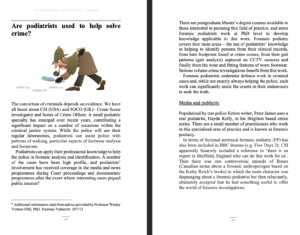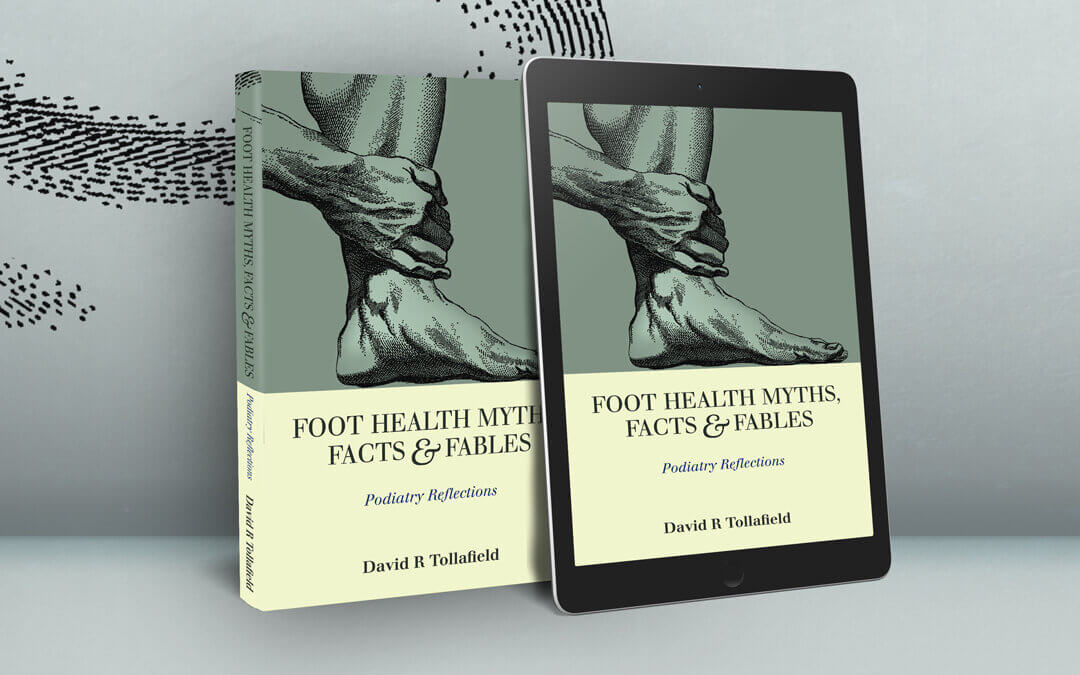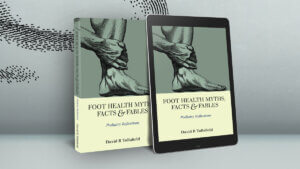A new book if you like reading tales
 Foot Health Myths, Facts & Fables
Foot Health Myths, Facts & Fables
When awaiting to start podiatry college in 1975, I was given a book list that was so unhelpful, uninspiring, demotivating and completely unintelligible as irrelevant to any understanding of the foot, the profession and foot disease. Why I enrolled with such a poor impression I can only put down to serendipity. From this small acorn, I held out, graduated and 40+ years later, after a successful career in a wonderful profession, being able to contribute to those who flounder when making that seminal career decision was and is my aim. Look no further if you cannot fathom our feet or the profession dedicated to such matters. Read Professor Tim Kilmartin’s Foreword below.
BUY NOW from Amazon Books
A book on foot health facts, myths & fables emerges
A bit of back story…
 I was invited to speak in Israel. Here, the myths, facts and fables started to take shape amongst a mixed group of professionals – podiatrists, orthopaedic surgeons and dermatologists. I have built on these with time, and what was a small book has grown after my manuscript lay dormant. The reason for a dedicated book on foot health is that non-foot specialists write most books on simple foot health. FACT and EVIDENCE always make us interested especially if humour is used. How does the reader navigate between good and bad advice, positive and negative, sales pitch and the genuine article? We need to pick our way through those myths or fiction passed from generation to generation to arrive at the facts. Plenty of books are written by people who want to share their personal philosophy and charge a big buck. You cannot fix bunions with exercise or yoga -but you may feel better relaxing! This is NOT a TEXTBOOK on feet, but it takes you into the world of foot science and podiatry.
I was invited to speak in Israel. Here, the myths, facts and fables started to take shape amongst a mixed group of professionals – podiatrists, orthopaedic surgeons and dermatologists. I have built on these with time, and what was a small book has grown after my manuscript lay dormant. The reason for a dedicated book on foot health is that non-foot specialists write most books on simple foot health. FACT and EVIDENCE always make us interested especially if humour is used. How does the reader navigate between good and bad advice, positive and negative, sales pitch and the genuine article? We need to pick our way through those myths or fiction passed from generation to generation to arrive at the facts. Plenty of books are written by people who want to share their personal philosophy and charge a big buck. You cannot fix bunions with exercise or yoga -but you may feel better relaxing! This is NOT a TEXTBOOK on feet, but it takes you into the world of foot science and podiatry.
Who should read this book?
This book is a foot health education resource with a twist. Anyone and everyone with an interest in feet and foot health, but the content is aimed at the lay reader who wants more, a prospective career student wondering if the foot is really an ugly part of the body with an uninspiring career. Why is podiatry so hidden from the public?
- Lay public and patients.
- School students thinking about what podiatry is about and why feet are important.
- Post A’level student reading.
- Undergraduates.
- Professionals.


Available in paperback and as an ebook
The substance in brief
The content primarily defines the causes of common foot conditions without suggesting that you should have a go or what treatment is best. Conditions are included that add to the image of the ‘Ugh Factor’, which may appear familiar and even attract comedy; sweaty feet, chilblains, ingrown toenails and ‘verrucas’ – all too commonly thought of as disorders of no consequence. The feet are an essential body organ. They are the first contact with the ground, the means to propel us forward, support us through our lives and allow us to climb, run and swim. They act as sensory organs that let us know what type of surface exists under our body. This book is illustrated. Topics and questions are referenced; the content list will help locate subjects, and the index at the end can act as a cross-reference.
Read the Foreward by Professor Tim Kilmartin, FRCPodS

The first book ever written about the foot was by the French barber surgeon Rousselot in 1755 and described by Walter Selig two hundred years later. Unfortunately, Selig somewhat spoiled the back story. The title was ‘Memoire sur les cors des pieds’ (‘A Dissertation on the corns of the feet’). The book came about after Rousselot explained to his students that because he was so very, very clever, he could write a book about anything to do with the human body, even the lowest of the low: the foot. Even this might have been mythical in that he allegedly relied heavily on Daniel Turner’s earlier book covering skin and such matters. Nicola-Laurent La Forest, surgeon-pedicurist to Louise XVI, published his own ‘treatise’ in 1781; treatise being a name given to papers and dissertations before the 20th century. La Forest covered corns warts, bunions, accidents of birth and deformities of the foot, which I suppose just about covers everything. Royal connections seem to have been very important to these men. So I was delighted to see the author, who takes his place in a line of luminaries, references Lewis Durlacher, a surgeon-chiropodist to Queen Victoria around 1845. He also gave his name to Durlacher’s corn. Although not quite Royal yet, Victoria and David Beckham also find themselves representing the footsore with their myriad foot problems.
Although I have been a practising podiatric surgeon for well over 30 years, I found this book a delight. It is the case that the foot with its 19 muscles, 115 ligaments and 28 bones is uniquely human no other living creature has a foot that works quite so mystically and with complex mechanics as that belonging to the human. Read this book, and you will find much about what it is to be human, not least the healthy dollops of sex and politics. But, unfortunately, in the 21st century, charlatanism in all its human forms is all around us. This book will go a long way to dispelling some of the snake oil fantasies that can cost the footsore so dear. I found this book a very warm cocoon to lose myself in, and I was utterly absorbed and enthralled by it.
Professor Tim Kilmartin PhD, FRCPodS.
Consultant Podiatric Surgeon
Ilkeston Derbyshire & Hillsborough N. Ireland
Available from Amazon Books
£4.99 eBook or £9.24 paperback
Other books from Author David R Tollafield
Published by Busypencilcase Reflective Communications. Est. 2015

21 June 2023


Trackbacks/Pingbacks